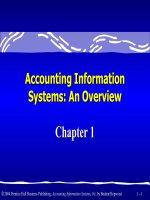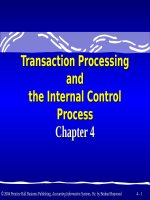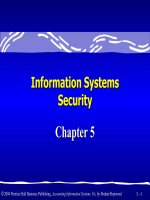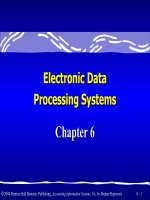Accounting information system an overview 9e bodnar hopwood chapter 04
Bạn đang xem bản rút gọn của tài liệu. Xem và tải ngay bản đầy đủ của tài liệu tại đây (4.32 MB, 47 trang )
Transaction Processing and
the Internal Control Process
Chapter 4
2004 Prentice Hall Business Publishing, Accounting Information Systems, 9/e, by Bodnar/Hopwood
4–1
Learning Objective 1
Understand the nature
of control exposures.
2004 Prentice Hall Business Publishing, Accounting Information Systems, 9/e, by Bodnar/Hopwood
4–2
Controls and Exposures
Controls are needed to reduce exposures.
An exposure consists of the potential
financial effect of an event multiplied
by its probability of occurrence.
Controls rarely affect the causes of exposures.
2004 Prentice Hall Business Publishing, Accounting Information Systems, 9/e, by Bodnar/Hopwood
4–3
Common Exposures
Excessive
costs
Business
interruption
Inaccurate
accounting
Deficient
revenues
EXPOSURES
Fraud and
embezzlement
Loss of
assets
Statutory
sanctions
Competitive
disadvantages
2004 Prentice Hall Business Publishing, Accounting Information Systems, 9/e, by Bodnar/Hopwood
4–4
Fraud and White-Collar Crime
What is white-collar crime?
Grouping of illegal activities that are differentiated
from other illegal activities in that they occur
as part of the occupation of the offender.
It often involves the entry of fictitious
transactions into an accounting system.
2004 Prentice Hall Business Publishing, Accounting Information Systems, 9/e, by Bodnar/Hopwood
4–5
Fraud and White-Collar Crime
Employee theft
Employee-outsider theft
Management fraud
2004 Prentice Hall Business Publishing, Accounting Information Systems, 9/e, by Bodnar/Hopwood
4–6
Fraud and White-Collar Crime
White-collar crime may result in
fraudulent financial reporting.
Corporate crime is a white-collar crime that
benefits a company or organization rather
than the individuals who perpetrate the fraud.
2004 Prentice Hall Business Publishing, Accounting Information Systems, 9/e, by Bodnar/Hopwood
4–7
Fraud and White-Collar Crime
What is forensic accounting?
Forensic accounting is one of several terms
used to describe the activities of persons
who are concerned with preventing and
detecting fraud and white-collar crime.
2004 Prentice Hall Business Publishing, Accounting Information Systems, 9/e, by Bodnar/Hopwood
4–8
Computer Processing
and Exposures
Computer processing can increase
the risk and/or potential
dollar loss of exposures.
Mechanical processing of data
Mechanical data storage
Complexity of processing
2004 Prentice Hall Business Publishing, Accounting Information Systems, 9/e, by Bodnar/Hopwood
4–9
Control Objectives
and Transaction Cycles
Most organizations experience the
same types of economic events.
These events generate transactions that
may be grouped according to four
common cycles of business activity.
2004 Prentice Hall Business Publishing, Accounting Information Systems, 9/e, by Bodnar/Hopwood
4–
Control Objectives
and Transaction Cycles
Revenue
cycle
Expenditure
cycle
Production
cycle
Finance
cycle
2004 Prentice Hall Business Publishing, Accounting Information Systems, 9/e, by Bodnar/Hopwood
4–
Control Objectives
and Transaction Cycles
Customers should be authorized in accordance
with management’s criteria.
Prices and terms of goods and services should be
authorized in accordance with management’s criteria.
All shipments of goods and services provided
should result in a billing to the customer.
Billings to customers should be accurately and
promptly classified, summarized, and reported.
2004 Prentice Hall Business Publishing, Accounting Information Systems, 9/e, by Bodnar/Hopwood
4–
Control Objectives
and Transaction Cycles
Vendors should be authorized in accordance
with management’s criteria.
Employees should be hired in accordance
with management’s criteria.
Access to personnel, payroll, and disbursement records should
be permitted only in accordance with management’s criteria.
Compensation rates and payroll deductions should be
authorized in accordance with management’s criteria.
Amounts due to vendors should be accurately and
promptly classified, summarized, and reported.
4–
2004 Prentice Hall Business Publishing, Accounting Information Systems, 9/e, by Bodnar/Hopwood
Control Objectives
and Transaction Cycles
The production plan should be authorized in
accordance with management’s criteria.
Cost of goods manufactured should be
accurately and promptly classified,
summarized, and reported.
2004 Prentice Hall Business Publishing, Accounting Information Systems, 9/e, by Bodnar/Hopwood
4–
Control Objectives
and Transaction Cycles
The amounts and timing of debt transactions
should be authorized in accordance with
management’s criteria.
Access to cash and securities should be permitted
only in accordance with management’s criteria.
2004 Prentice Hall Business Publishing, Accounting Information Systems, 9/e, by Bodnar/Hopwood
4–
Learning Objective 2
Discuss the concept of the
internal control process.
2004 Prentice Hall Business Publishing, Accounting Information Systems, 9/e, by Bodnar/Hopwood
4–
External Influences Concerning
an Entity and Internal Control
The Federal Foreign Corrupt Practices Act of
1977 (FCPA) is a specific legal requirement
that concerns many organizations.
It requires all companies who are subject to
the Securities Exchange Act of 1934 to...
2004 Prentice Hall Business Publishing, Accounting Information Systems, 9/e, by Bodnar/Hopwood
4–
External Influences Concerning
an Entity and Internal Control
...make and keep books, records,
and accounts, which in reasonable
detail, accurately and fairly reflect
the transactions and dispositions
of the assets of the issuer;
devise and maintain a system of internal
accounting controls sufficient to
provide reasonable assurance that...
2004 Prentice Hall Business Publishing, Accounting Information Systems, 9/e, by Bodnar/Hopwood
4–
External Influences Concerning
an Entity and Internal Control
1. transactions are executed in accordance
with management’s authorization;
2. transactions are recorded as necessary;
3. access to assets is permitted only in
accordance with management’s authorization;
4. the recorded accountability for assets
is compared with the existing assets.
2004 Prentice Hall Business Publishing, Accounting Information Systems, 9/e, by Bodnar/Hopwood
4–
External Influences Concerning
an Entity and Internal Control
5-member Public Company
Accounting Oversight Board
Restrictions on nonaudit services
Role of the audit committee
2004 Prentice Hall Business Publishing, Accounting Information Systems, 9/e, by Bodnar/Hopwood
4–
External Influences Concerning
an Entity and Internal Control
Conflicts of interest
Corporate responsibility
for financial reports
Insider trades during pension
fund blackout periods prohibited
2004 Prentice Hall Business Publishing, Accounting Information Systems, 9/e, by Bodnar/Hopwood
4–
External Influences Concerning
an Entity and Internal Control
Prohibition on personal loans
to executives and directors
Code of ethics
Management assessment
of internal controls
2004 Prentice Hall Business Publishing, Accounting Information Systems, 9/e, by Bodnar/Hopwood
4–
Components of the Internal
Control Process
An organization’s internal control
process consists of five elements:
1. Control environment
2. Risk assessment
3. Control activities
4. Information and communication
5. Monitoring
2004 Prentice Hall Business Publishing, Accounting Information Systems, 9/e, by Bodnar/Hopwood
4–
Control Environment
The first component of internal
control is the control environment.
Factors included in the control
environment are as follows:
Integrity and ethical values
Commitment to competence
2004 Prentice Hall Business Publishing, Accounting Information Systems, 9/e, by Bodnar/Hopwood
4–
Control Environment
Management philosophy and operating style
Organizational structure
Attention and direction provided by the
board of directors and its committees
Manner of assigning authority and responsibility
Human resource policies and procedures
2004 Prentice Hall Business Publishing, Accounting Information Systems, 9/e, by Bodnar/Hopwood
4–









